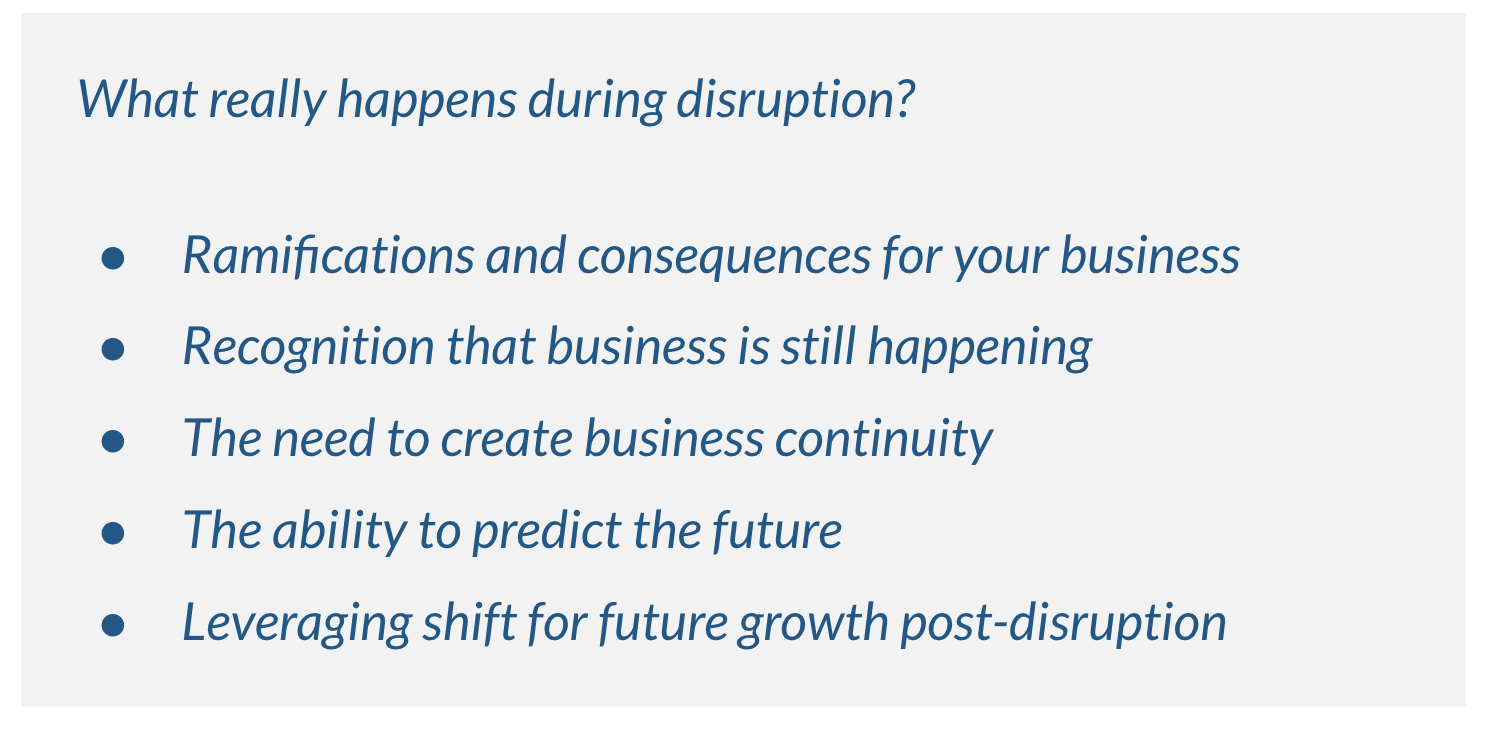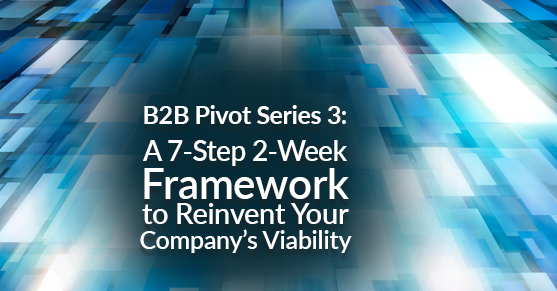Business disruptions happen consistently in terms of global demand and supplies, needs and wants – and especially now. Successful organizations reflect on what constitutes their larger marketplace to ensure long-term viability methodically, predictably and quickly. There are methodical ways for companies to facilitate conversations that matter, both for strategic survival and to build long-term relationships. Let’s consider what you can do to ensure your company’s long-term viability starting now.
Reinvention can be born from extreme necessity. Despite disruption within a dynamic, already moving, already-evolving business landscape, remember business IS still happening. The difference is that consumer buying priorities and patterns have shifted. Everybody is doing the dance, whatever that dance is – for our purposes here, let’s call that dance ‘reinvention’. Following is a framework you can use to understand your customers and respond to their needs while stabilizing your own infrastructure.
First, let’s consider what really happens during disruption. Disruption is a form of creative destruction. It is about looking at – in undeniable urgency – the ramifications and consequences of current events for your business continuity.
The term creative destructionism was coined by Joseph Schumpeter in 1942. He theorized creative destruction was the dismantling of longstanding practices to facilitate innovation. At the time, he was observing manufacturing and transportation innovations in the 20th century. Those observations have held true through artificial intelligence (AI), autonomous vehicles, regenerative tissues and more. What he didn’t address then was the impact of a global transformation kicked off by a pandemic. In any case, creative destructionism is a concept that still holds true for what’s happening today.

Throughout disruption, there’s a need for companies to create business continuity, the desire to be able to predict the future, and leverage the shift(s) for future growth post-disruption. All these things are possible. One approach is to use the following seven-step framework that can be accomplished in two or three weeks, depending on your capabilities, capacities and urgencies.
The 7 Step Framework
The following framework is designed to be a quick-start action plan, initiated and going to market within three weeks. This timeframe requires all hands on deck. The actual timing may vary; remember that there is power in fast, targeted reinvention. That’s the goal with this framework.
Step 1: Attitude
Leaders must provide optimism to and for customers, future customers and employees about the potential opportunities and shifts caused by disruptive forces. Leaders need to have the vision and then the ability to communicate it to create a growth context for all stakeholders.
This context shares leadership perspective, experience and supportive solutions. Business audiences need to know leaders care, are behind them and are ready to do what’s possible to facilitate forward momentum. The bonus is that, regardless of specific outcomes in the moment, this approach will deepen relationships that will likely stand the test of time post-disruption.
As a leader, make sure you are helping people process what’s happening and then advising them through decision-making how to move forward. Ask about people’s most pressing concern(s), then share what your company is doing (or could do, once known) to address those concerns. In the absence of a solution today as a response, a leader can say, “Let me look into that, and then come back for a follow-up.” Why wouldn’t you want to wing a response or improvise or give someone platitudes to soothe them? Because it will cost credibility and trust in the long run. Authenticity, transparency, generosity of spirit and knowledge builds relationships – anything else will lose trust and could cost the relationship in the long-term.
Step 2: Reality Check
Before you can actually connect with your audiences, you need perspective which is gained through a reality check. Disruption amplifies whatever was already happening in your company before the disruption, so ask some tough questions for clarity.
- How was your company doing before this happened?
- What’s your corporate culture?
- How resilient are your people?
- What’s the bounce-back factor?
- What is your corporate strategy? Does it still make sense? Do you need to refine it?
These kinds of questions can jumpstart significant conversations. It’s natural to see fears surface as a result of asking or answering these questions. Regardless, it’s important to acknowledge the current status of what ‘is’ currently, then move discussions to what you’re doing next to improve those outcomes.
Step 3: Get Strategic
Gather company leaders to enlist their support for this jumpstart process. Ensure everyone sees the need to change tactical directions to enable the larger strategy. Your goal is to capture what people know – customer concerns, likely discretionary changes for your customers as they adapt to the disruption, untapped resources, fresh opportunities and anything else circulating at the moment.
Think through what your customers are likely and/or need to do to survive, then think through what would be logical for them to do. Then consider what you could do to leverage this disruption for thriving through innovations your customers may not be considering yet. Get clear on your new value-add(s) so you can strategically adjust to your customer’s needs and concerns.
Your company may be able to take an existing solution and ‘twist’ it to be more helpful. Or maybe you have enough progress on a new solution that you could fast track it to help your customers. What could your company do differently to be even more helpful for your customers? That will inform your strategy going forward.
Step 4: Brainstorm
At this point, open the doors of innovation for potential solutions to all your team members. Whether people are in customer-facing or back-office roles, people in the business of doing your business will suggest customer-centric services from their point of view that could be helpful. This process also increases team buy-in, generates great ideas and, possibly, changes the course of progress for both your company and your customers.
Once you have defined your new innovations or solutions options, your management team needs to come together with three ideas for each idea.
1) Your management team needs to come up with either a new service, new spin on an existing service, or an upgraded service to help your current and future customers and/or your employees. Remember, you have both internal (staff) and external (paying) customers – and you need both to be successful.
2) Your management teams needs to develop the conceptual pitch or close for that upgraded or new solution, as well as delivery of it.
Within the week, you want to vet those ideas for the greatest potential positive impact. Look at ease of launching them, consider the resource viability, and then agree on going to market with them very quickly. Within the next two weeks, you want to get ahead of whatever’s happening in the market for your customers.
Step 5: Productive and Systematize
With these new solutions identified, it’s time to get traction with them by productizing and systematizing your new solutions. That means considering what resources you have in-house by either using existing or re-allocating resources, including the people who will make these solutions happen. While you may need to expand resources, for now, focus on what you can do with the resources you can quickly access.
Your leaders need to define the framework, methodology and tools for each new service you want to go-to-market with in the next week. That might mean taking some of your best people off current commitments to make the investment successful because you want to be responsive and jumpstart this initiative very quickly.
Step 6: Marketing
Marketing is helping your audiences understand what’s available to help them in easy-to-understand language via great content. It’s one thing to gear up to help your employees, customers and future customers, but if they don’t know what is now available to them, or they don’t understand how it works or how to access it, that solution will not be helpful. The only way to get momentum with your new solutions is to market what you’ve come up with for visibility and consumption by your audience(s).
Following is a quick list of tactics you can use to get the word out: 1) update your website, 2) update your website navigation or SEO, 3) create downloadable documents, 4) send a special edition of your newsletter, 5) do a video of company leaders talking about these new solutions and there are others. Remember, marketing is step one of sales in that marketing provides context and makes the case for your customers to consider those new solutions. Sales then personalizes that solution and closes the deal. Marketing and sales work hand-in-hand and should be cohesive and seamless for your future and current customers.
Step 7: Sales
During times of disruption, sales is about building relationships with your existing customers. Why? Because it’s not likely companies are looking to spend money with a new provider which means you are not likely to attract new business at the moment. However, those who know, like, and trust your company already are likely to either expand or reallocate their resources to work more extensively with you.
Make sure your plan is solid by asking each of your sales reps to call two of their most trusted clients; during those conversations, your reps should ask about pressing needs and concerns, and then confirm what your company is thinking re: new solutions to get feedback. Do not sell on these calls! Ask and listen. The voice of your customer(s) will ensure your new offerings delivery is on target.
This is a ‘prime the pump’ kind of approach by using check-in calls with every active account during week two. “How are you doing? How are things going? What are you seeing? What do you believe will help you?” Just about anybody appreciates that kind of call when someone asks, “Hey, how are you doing?”
 Ideally, this activity happens during week one or two, depending on the pace of reinvention in your company. In any case, you want to do this as quickly, efficiently, and effectively as possible. The admittedly assertive goal is to launch your new service two weeks from the day your leadership first meets; that said, timing may adjust as you get into the actual process.
Ideally, this activity happens during week one or two, depending on the pace of reinvention in your company. In any case, you want to do this as quickly, efficiently, and effectively as possible. The admittedly assertive goal is to launch your new service two weeks from the day your leadership first meets; that said, timing may adjust as you get into the actual process.
During these initial check-in calls, you may find an opportunity to advise your customer on business strategies or their adaptations. This conversation is a mutual consultation about pain points and needs as the precursor to exploring solutions. Your customer’s pain points might be a match for your company’s pain point – the desire to serve more deeply. These conversations may surface those types of connection points; in that case, be prepared to valuable insights and information. Schedule a next-level call if you need to offer additional expertise or time, then make sure you have the right team ready for that next call.
These types of conversations during times of crisis can create blood bonds for life. When you’re telling the truth – showing up, being authentic, being transparent, caring, having empathy, you and your conversation partner join to confront a mutual enemy. You’re in this together, handling, neutralizing or making the most of the effects of disruption. In a way, you become what people used to call ‘comrades in arms’. When you do it right, you turn disruption into shared opportunity – this is the blood bond. You’ve been through an ordeal together and, chances are, you’ll have a relationship for the rest of your life.
You now have a 7-step framework you can use in just two weeks to leverage disruption into opportunity. It takes your team pulling together to make it happen.

In week one, you start pivoting for reinvention, get your attitude together, do the reality check, get strategic and brainstorm. From brainstorming, you want to productize, systematize and get ready to roll in week one and a half or two, at which point you put your marketing together. In week two-ish (or three), you get your sales system in gear.
Simply by working through this process creatively, you’re going to position for long-term relationships post-disruption with employees as well as current and future customers. This is a very condensed approach designed to jumpstart fresh momentum. And you will get some return on your investment, even if it’s not exactly what you predict in the beginning.
Want to chat further about how to jumpstart your reinvention? Please reach out. I would love to hear what you’re doing and offer whatever I know to help.
Note: this framework originated from Jim Orrison, an XTIVIAN working in our Enterprise Information Management Division. I had the honor of adding a little more meat so I could present it to you.
To access our entire B2B Pivot Series, it is available for download here.

